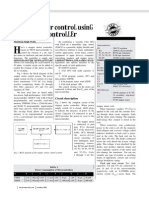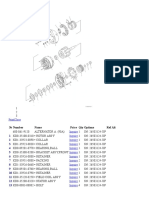Railway Accident Monitoring System: A Project Report ON
Railway Accident Monitoring System: A Project Report ON
Uploaded by
Prateek SrivastavCopyright:
Available Formats
Railway Accident Monitoring System: A Project Report ON
Railway Accident Monitoring System: A Project Report ON
Uploaded by
Prateek SrivastavOriginal Title
Copyright
Available Formats
Share this document
Did you find this document useful?
Is this content inappropriate?
Copyright:
Available Formats
Railway Accident Monitoring System: A Project Report ON
Railway Accident Monitoring System: A Project Report ON
Uploaded by
Prateek SrivastavCopyright:
Available Formats
A
PROJECT REPORT
ON
RAILWAY ACCIDENT MONITORING
SYSTEM
Session: 2013-2014
HOD : Under the guidance:
Prof. B.S. Rai Prof. R.K. Prasad
Submitted by:
Pankhuri Agrawal (1004231043)
Prateek Srivastav (1004231045)
Prince Kr. Singh (1004231047)
Vaibhav Patel (1004231067)
MADAN MOHAN MALAVIYA UNIVERSITY OF TECHNOLOGY,
GORAKHPUR
Contents
1. Objective
2. Elements Used
2.1 Atmega 16
2.2 L293D
2.3 TSOP sensors
3. Theory
3.1 Speed Control
3.2 Fire Detection
3.3 Head-on collision
References
RAILWAY ACCIDENT MONITORING SYSTEM
OBJECTIVE:
The purpose of the project is to control the railway accidents using automation. The project consists of:
Avoiding head-on collision of two trains
Decreasing the velocity of train on bridges
Control fire accidents
ELEMENTS USED:
Microcontroller-ATMEGA 16
L293D (motor driver)
TSOP sensors
ATMEGA 16:
The ATmega16 is a low-power CMOS 8-bit microcontroller based on the AVR enhanced RISC
architecture.By executing powerful instructions in a single clock cycle, the ATmega16 achieves
throughputs approaching1 MIPS per MHz allowing the system designed to optimize power consumption
verses processing speed.
Features
Advanced RISC Architecture
Up to 16 MIPS Throughput at 16 MHz
16K Bytes of In-System Self-Programmable Flash
512 Bytes EEPROM
1K Byte Internal SRAM
32 Programmable I/O Lines
In-System Programming by On-chip Boot Program
8-channel, 10-bit ADC
Two 8-bit Timer/Counters with Separate Prescalers and Compare Modes
One 16-bit Timer/Counter with Separate Prescaler, Compare Mode, and Capture
Four PWM Channels
Programmable Serial USART
Master/Slave SPI Serial Interface
Byte-oriented Two-wire Serial Interface
Programmable Watchdog Timer with Separate On-chip Oscillator
External and Internal Interrupt Sources
Pin Diagram:
Pin Descriptions
VCC: Digital supply voltage. (+5V)
GND: Ground. (0 V) Note there are 2 ground Pins.
Port A (PA7 - PA0) :Port A serves as the analog inputs to the A/D Converter. Port A also serves
as an 8-bit bi-directional I/O port, if the A/D Converter is not used. When pins PA0 to PA7 are
used as inputs and are externally pulled low, they will source current if the internal pull-up
resistors are activated. The Port A pins are tri-stated when a reset condition becomes active, even
if the clock is not running.
Port B (PB7 - PB0) Port B is an 8-bit bi-directional I/O port with internal pull-up resistors
(selected for each bit). Port B also serves the functions of various special features of the
ATmega16 as listed on page 58 of datasheet.
Port C (PC7 - PC0) Port C is an 8-bit bi-directional I/O port with internal pull-up resistors
(selected for each bit). Port C also serves the functions of the JTAG interface and other special
features of the ATmega16 as listed on page 61 of datasheet. If the JTAG interface is enabled, the
pull-up resistors on pins PC5 (TDI), PC3 (TMS) and PC2 (TCK) will be activated even if a reset
occurs.
Port D (PD7 - PD0) Port D is an 8-bit bi-directional I/O port with internal pull-up resistors
(selected for each bit). Port D also serves the functions of various special features of the
ATmega16 as listed on page 63 of datasheet.
RESET: Reset Input. A low level on this pin for longer than the minimum pulse length will
generate a reset, even if the clock is not running.
XTAL1: External oscillator pin 1
XTAL2: External oscillator pin 2
AVCC: AVCC is the supply voltage pin for Port A and the A/D Converter. It should be externally
connected to
VCC, even if the ADC is not used. If the ADC is used, it should be connected to VCC through a
low-pass filter.
AREF: AREF is the analog reference pin for the A/D Converter.
L293D:
L293D is a dual H-bridge motor driver integrated circuit (IC). Motor drivers act as current amplifiers
since they take a low-current control signal and provide a higher-current signal. This higher current signal
is used to drive the motors.L293D contains two inbuilt H-bridge driver circuits. In its common mode of
operation, two DC motors can be driven simultaneously, both in forward and reverse direction. The motor
operations of two motors can be controlled by input logic at pins 2 & 7 and 10 & 15. Input logic 00 or 11
will stop the corresponding motor. Logic 01 and 10 will rotate it in clockwise and anticlockwise
directions, respectively.Enable pins 1 and 9 (corresponding to the two motors) must be high for motors to
start operating. When an enable input is high, the associated driver gets enabled. As a result, the outputs
become active and work in phase with their inputs. Similarly, when the enable input is low, that driver is
disabled, and their outputs are off and in the high-impedance state.
Pin Diagram:
Pin Description:
Pin No Function Name
1 Enable pin for Motor 1; active high Enable 1,2
2 Input 1 for Motor 1 Input 1
3 Output 1 for Motor 1 Output 1
4 Ground (0V) Ground
5 Ground (0V) Ground
6 Output 2 for Motor 1 Output 2
7 Input 2 for Motor 1 Input 2
8 Supply voltage for Motors; 9-12V (up to 36V) Vcc
2
9 Enable pin for Motor 2; active high Enable 3,4
10 Input 1 for Motor 1 Input 3
11 Output 1 for Motor 1 Output 3
12 Ground (0V) Ground
13 Ground (0V) Ground
14 Output 2 for Motor 1 Output 4
15 Input2 for Motor 1 Input 4
16 Supply voltage; 5V (up to 36V) Vcc
1
TSOP Sensors:
TSOPs are rectangular in shape and come in two varieties: Type I and Type II. Type I ICs have the pins
on the shorter side and Type II have the pins on the longer side. The table below shows basic
measurements for common TSOP packages.
The TSOP 1738 is a member of IR remote control receiver series. This IR sensor module consists of a
PIN diode and a pre amplifier which are embedded into a single package. The output of TSOP is active
low and it gives +5V in off state. When IR waves, from a source, with a centre frequency of 38 kHz
incident on it. Lights coming from sunlight, fluorescent lamps etc. may cause disturbance to it and result
in undesirable output even when the source is not transmitting IR signals. A bandpass filter, an integrator
stage and an automatic gain control are used to suppress such disturbances.
TSOP module has an inbuilt control circuit for amplifying the coded pulses from the IR transmitter. A
signal is generated when PIN photodiode receives the signals. This input signal is received by an
automatic gain control (AGC). For a range of inputs, the output is fed back to AGC in order to adjust the
gain to a suitable level. The signal from AGC is passed to a band pass filter to filter undesired
frequencies. After this, the signal goes to a demodulator and this demodulated output drives an npn
transistor. The collector output of the transistor is obtained at pin 3 of TSOP module.
Members of TSOP17xx series are sensitive to different centre frequencies of the IR spectrum. For
example TSOP1738 is sensitive to 38 kHz whereasTSOP1740 to 40 kHz centre frequency.
THEORY:
1. Speed Control
The aim of developing this project is to control the speed of DC motor. The main advantage in using a
DC motor is that the Speed-Torque relationship can be varied to almost any useful form. To achieve the
speed control an electronic technique called Pulse Width Modulation is used which generates High and
Low pulses. These pulses vary the speed in the motor. For the generation of these pulses a microcontroller
(AT89c51) is used. As a microcontroller is used setting the speed ranges as per the requirement is easy
which is done by changing the duty cycles time period in the program. This project is practical and highly
feasible in economic point of view, and has an advantage of running motors of higher ratings. This project
gives a reliable, durable, accurate and efficient way of speed control of a DC motor.
1. Microcontroller can provide signals to start, stop, forward or backward movement, but cannot
provide the power needed to run the DC motors.
2. To run DC motors, we need an interfacing circuit, commonly called as driver. It sits between the
microcontroller and the DC motors. Its prime job is to accept signals from the microcontroller and
then translate those signals into a high power circuit (meaning, microcontroller signals could be
5V, 20 mA while the output from the driver could be at 12V 300mA)
3. The power supply for microcontroller is different from the power supply for the motors. There
exists a common ground between the two to have a common reference point.
The whole idea can be outlined as given in the picture below:
DC Motor Control Block Diagram
2. Fire Detection in Trains
Fire is often unpredictable and hard to avoid, and an efficient fire-alarm system isof vital importance for
the protection of lives and assets. In addition to this, fireprotection on trains is very complicated due to the
electrical environment,vibrations, and variation in temperature and humidity, which can all interfere
withthe system's functionality.To meet the demands on efficient fire detection and to develop an
interferencefreesystem, without the other-wise common false alarms, smokeand fire-detection systems for
trains are based on the same technique used forinstallations on-board NATO submarines and other
extreme environments.
Addressable fire-detection systems for trains:
TS1000 is an addressable fire-detection system for trains that supervises alltypes of areas and
environments, including engine rooms, passenger areas andcable installations.Running capability, from a
fire-protection point of view, is the possibility for thedriver or train operator to have full control over the
location of the fire and itsprogress while running the train to a place where passengers can safely leavethe
train.Its aim is to always ensure full running capability. Therefore, theTS1000 offers full redundancy
regarding communication between detectors,operator panels and the train's computer.
TS1000 also offers an additional form of safety and runningcapability, as it is possible to integrate and
supervise and control severaldifferent functions such as:
Extinguishing and suppression systems
Ventilation and air-conditioning systems
Electrical appliances such as heaters
Cooking appliances
Fuel system
By offering such capability, it is not only the safety of passengers and people inthe surroundings that can
be ensured by our integrated and flexible fire-detectionsystem for trains. Such a solution also reduces the
stand-still of the train,minimizing the disturbance in operation and reducing the cost of repair.
BLOCK DIAGRAM:
3. Head-on collision:
This project is implemented by connecting Ultrasonic Sensors in front of the train. The Ultrasonic
sensors will give the distance between the present train and the train which is coming in the opposite
direction. The distance is constantly monitored by a microcontroller and when the distance is close, it is
programmed to regulate the speed and also to stop the train if it is necessary.
Parameter Monitoring :
Since our project is related to the vehicles, in addition to the mentioned aim we can also monitor
the temperature of the Vehicle. The engine temperature is measured by using the thermistor which is
connected to an ADC of ATMEGA16 Microcontroller.
BLOCK DIAGRAM
Thermistor
Potential
Divider
ATMEGA 16
Distance Input (TSOP)
Stepper Driver
Stepper
Motor
Power
Supply
+5VDC
Stepper
Power
Supply
+12VDC
Block Diagram Explanation
Power Supply:
Used to power the ATMEGA 16 Microcontroller. This is generated from the incoming AC supply of
230V.
Stepper Power Supply:
Used to run the Stepper Motor.This is generated from the incoming AC supply of 230V.
Stepper Driver and Opt coupler:
The TTL Level Pulse signal from the controller is not sufficient to run the stepper motor as it requires the
current of 1.2 amps. So the signals from the controller are buffered and isolated and amplified using
transistors. Then the amplified voltage is applied to the stepper motor. The stepper driver board does this
job.
Ultrasonic Sensors:
These ultrasonic sensors are used to measure the distance between the current train and the opposite train.
The ultrasonic sensor has a transmitter and receiver placed side by side. The ultrasonic sound waves are
transmitted, and if there is any obstacle, the waves are reflected back and it is sensed by the receiver. The
unit then calculates the travel time of the wave and converts it into distance.
Thermistor and Potential divider:
It is a transducer which is used to measure the temperature of engine. The resistance of the device varies
according to the atmospheric temperature. The resistance variation from the thermistor is converted into
its corresponding voltage variation using this voltage divider circuit.
LCD Display:
A 16X2 row LCD Display is used to display the parameters sensed and the events happening.
Conclusion and future enhancements:
In this project we have used ultrasonic sensors for detecting the opposite train. This distance can be
increased by putting long range ultrasonic level sensors. We can also incorporate a GPS and GSM
Modules for preventing train accidents. The GPS Lets us to know the present location and GSM Sends it
to another train. Thus if the two trains are at the same location then the train is immediately stopped.
REFERENCES
1.The 8051 Microcontroller and Embedded Systems By Muhammad Ali Mazidi
2.Fundamentals Of Embedded Software By Daniel W Lewis
3.www.howsstuffworks.com
4.www.alldatasheets.com
5.www.electronicsforu.com
6. www.knowledgebase.com
7. www.8051 projectsinfo.com
8. Datasheets of Microcontroller AT89S52
You might also like
- Mini Project Report-2Document26 pagesMini Project Report-2Remya Ramakrishnan0% (2)
- Cadence VCODocument59 pagesCadence VCOVăn Công100% (3)
- Project Report: Topic:-Portable Mobile ChargerDocument15 pagesProject Report: Topic:-Portable Mobile ChargerrohitkgangotiaNo ratings yet
- WIRE LESS Land Mine Detection Robo-VehicleDocument35 pagesWIRE LESS Land Mine Detection Robo-VehicleDebashish BeheraNo ratings yet
- WeatherDocument74 pagesWeatherPrittam Kumar JenaNo ratings yet
- Railway GateDocument46 pagesRailway GateRocky SinghNo ratings yet
- Thyristor Power Control by IR RemoteDocument22 pagesThyristor Power Control by IR Remotevivek100% (2)
- Ac Voltage Controller Using Thyristor Project Report by SandeepDocument29 pagesAc Voltage Controller Using Thyristor Project Report by SandeepSANDEEP DHANDA100% (1)
- Seminar Report On Missile Detection SystemDocument26 pagesSeminar Report On Missile Detection SystemSaurabh SinghNo ratings yet
- The Drive Design of The STM32-based Brushless DC Motor: Song Wang, Wang Guo, Wenqiang DunDocument9 pagesThe Drive Design of The STM32-based Brushless DC Motor: Song Wang, Wang Guo, Wenqiang DunMarco LisiNo ratings yet
- Final Report On Line Follower RobotDocument44 pagesFinal Report On Line Follower RobotAjay Verma50% (4)
- Institute of Engineering and Technology, Alwar, Rajasthan: Wireless Keypad Controlled RobotDocument44 pagesInstitute of Engineering and Technology, Alwar, Rajasthan: Wireless Keypad Controlled RobotTwinkle SinghNo ratings yet
- Chapter Three2Document12 pagesChapter Three2Fuh ValleryNo ratings yet
- Automatic Room Light Controller With Bidirectional Visitor CounterDocument37 pagesAutomatic Room Light Controller With Bidirectional Visitor Counteramysure150% (2)
- SLS11Document27 pagesSLS11maneeshNo ratings yet
- Advanced Three Phase PWM Inverter Control Using MicrocontrollerDocument8 pagesAdvanced Three Phase PWM Inverter Control Using MicrocontrollerAbdur Rehman TayyabNo ratings yet
- Arm Cortex (LPC 2148) Based Motor Speed ControlDocument25 pagesArm Cortex (LPC 2148) Based Motor Speed ControlUday Wankar100% (1)
- DC Motor Speed ControlDocument23 pagesDC Motor Speed ControlVibhu BansalNo ratings yet
- Chapter One Controlling The Operation of Wind-Solar Hybrid Power System Using Arduino-Based Hybrid MPPT ControllerDocument48 pagesChapter One Controlling The Operation of Wind-Solar Hybrid Power System Using Arduino-Based Hybrid MPPT ControllerOdebunmi NathanielNo ratings yet
- Vehicle Speed Control System Using RF CommunicationDocument20 pagesVehicle Speed Control System Using RF CommunicationRaina John100% (2)
- Speed Detector For HighwaysDocument29 pagesSpeed Detector For HighwaysShama MahinNo ratings yet
- Microcontroller Based DC Motor Control: Jayshree Sahu, S.K.Sahu, Jayendra KumarDocument4 pagesMicrocontroller Based DC Motor Control: Jayshree Sahu, S.K.Sahu, Jayendra KumarJagdish PatankarNo ratings yet
- Final ReportDocument42 pagesFinal ReportAwadh SinghNo ratings yet
- Highway Speed CheckerDocument24 pagesHighway Speed Checkerritesh chauhanNo ratings yet
- Temp Measurment Using GSMDocument12 pagesTemp Measurment Using GSMRavi JoshiNo ratings yet
- IR Radar With Laser Shoot - SYNOPSISDocument11 pagesIR Radar With Laser Shoot - SYNOPSISashishkvianNo ratings yet
- 00718a - Brush-DC Servomotor Implementation Using PIC17C756ADocument33 pages00718a - Brush-DC Servomotor Implementation Using PIC17C756AadisaksNo ratings yet
- (212142518) Stepper Motor Control Using MicrocontrollerDocument4 pages(212142518) Stepper Motor Control Using MicrocontrollerraghavthakurjiNo ratings yet
- Automatic Room Light ControllerDocument26 pagesAutomatic Room Light ControllerdamasNo ratings yet
- Qs & As Class I+IIDocument9 pagesQs & As Class I+IIphyoNo ratings yet
- MICROCONTROLLER-based DC Motor Speed ControllerDocument8 pagesMICROCONTROLLER-based DC Motor Speed Controllerranjithsim100% (1)
- Communication Antenna Switching System Based On Micro ControllerDocument4 pagesCommunication Antenna Switching System Based On Micro ControllerAjay Kumar YadavNo ratings yet
- Design and Implementation of Digital Trigger Circuit For ConverterDocument6 pagesDesign and Implementation of Digital Trigger Circuit For ConverterBilal Ali AhmadNo ratings yet
- Home Security System Using Microcontroller 8051: Project Synopsis OnDocument19 pagesHome Security System Using Microcontroller 8051: Project Synopsis OndeepeshNo ratings yet
- Remote Tracking and Breaking System For VehiclesDocument5 pagesRemote Tracking and Breaking System For VehiclesseventhsensegroupNo ratings yet
- Auto LightDocument37 pagesAuto LightKrishna MalhotraNo ratings yet
- Traffic Light Control SystemDocument12 pagesTraffic Light Control SystemVinay ReddyNo ratings yet
- Index: Objective Introduction Circuit Description List of Components Circuit Diagram Components DescriptionDocument19 pagesIndex: Objective Introduction Circuit Description List of Components Circuit Diagram Components DescriptionKrishnaBihariShuklaNo ratings yet
- WorkingDocument3 pagesWorkingAnuj TripathiNo ratings yet
- Atmel PWM Fan ControlDocument10 pagesAtmel PWM Fan ControlArijan BogovićNo ratings yet
- MC3PHACDocument36 pagesMC3PHACBảo BìnhNo ratings yet
- SPEED CHECKER FOR HI-WAsYSDocument26 pagesSPEED CHECKER FOR HI-WAsYSAbhinav KumaarNo ratings yet
- Vehicle Speed Control System Using RF CommunicationDocument80 pagesVehicle Speed Control System Using RF CommunicationSaheb Amrinder100% (6)
- Chapter 1. OverviewDocument58 pagesChapter 1. OverviewmgitecetechNo ratings yet
- Hand Gesture Control Robot PDFDocument3 pagesHand Gesture Control Robot PDFMd IrfanNo ratings yet
- Train Speed Control F S KDocument54 pagesTrain Speed Control F S KDivya SantoshiNo ratings yet
- Ir Remote Based Stepper Motor Control PDFDocument70 pagesIr Remote Based Stepper Motor Control PDFsanoopmk100% (1)
- RPM IndicatorDocument39 pagesRPM IndicatorAnkur PatelNo ratings yet
- Print OutDocument13 pagesPrint Outnazece08No ratings yet
- Helmet MiniDocument56 pagesHelmet MiniSumanth Varma100% (1)
- N568PPTDocument29 pagesN568PPTRavi PexelsNo ratings yet
- Reference Guide To Useful Electronic Circuits And Circuit Design Techniques - Part 2From EverandReference Guide To Useful Electronic Circuits And Circuit Design Techniques - Part 2No ratings yet
- Reference Guide To Useful Electronic Circuits And Circuit Design Techniques - Part 1From EverandReference Guide To Useful Electronic Circuits And Circuit Design Techniques - Part 1Rating: 2.5 out of 5 stars2.5/5 (3)
- Analog Dialogue, Volume 48, Number 1: Analog Dialogue, #13From EverandAnalog Dialogue, Volume 48, Number 1: Analog Dialogue, #13Rating: 4 out of 5 stars4/5 (1)
- Simulation of Some Power Electronics Case Studies in Matlab Simpowersystem BlocksetFrom EverandSimulation of Some Power Electronics Case Studies in Matlab Simpowersystem BlocksetNo ratings yet
- Simulation of Some Power Electronics Case Studies in Matlab Simpowersystem BlocksetFrom EverandSimulation of Some Power Electronics Case Studies in Matlab Simpowersystem BlocksetNo ratings yet
- Tcs Ilp Pat Test On JavaDocument3 pagesTcs Ilp Pat Test On JavaPrateek Srivastav100% (1)
- Chapter 2Document88 pagesChapter 2ttambatamba100% (1)
- 8085 Microprocessor Ramesh S. GaonkarDocument330 pages8085 Microprocessor Ramesh S. Gaonkarrohit31bark64% (22)
- Placement Report 2013: Department of Management Studies Indian Institute of Technology MadrasDocument4 pagesPlacement Report 2013: Department of Management Studies Indian Institute of Technology MadrasPrateek SrivastavNo ratings yet
- Centre Allotment Ima 137 CourseDocument87 pagesCentre Allotment Ima 137 CoursePrateek SrivastavNo ratings yet
- Madan Mohan Malaviya Engineering College, Gorakhpur: Subject Registration DetailDocument1 pageMadan Mohan Malaviya Engineering College, Gorakhpur: Subject Registration DetailPrateek SrivastavNo ratings yet
- Apply Filters All Classes Get Seat Availability Refresh Tot SeatsDocument3 pagesApply Filters All Classes Get Seat Availability Refresh Tot SeatsPrateek SrivastavNo ratings yet
- Soniye Hiriye Teri Yaad Aandi YeDocument1 pageSoniye Hiriye Teri Yaad Aandi YePrateek SrivastavNo ratings yet
- Pro Custom Series Sat150: Data SheetDocument2 pagesPro Custom Series Sat150: Data SheetVishal SuryawaniNo ratings yet
- Service Manual: Air Fryer HD9225/50 HD9225/51 HD9225/52 HD9225/53 HD9220/50Document9 pagesService Manual: Air Fryer HD9225/50 HD9225/51 HD9225/52 HD9225/53 HD9220/50JOHN SEBASTIAN ZULUAGA OSORIONo ratings yet
- Unit IiiDocument90 pagesUnit Iiivlsimicroelectronics.sseNo ratings yet
- 08 - ElectricityDocument113 pages08 - Electricity240151270No ratings yet
- The Metal Oxide FETDocument7 pagesThe Metal Oxide FETSitty GuNo ratings yet
- Electron Theory: Akd10102: Electrical Fundamendal 1Document14 pagesElectron Theory: Akd10102: Electrical Fundamendal 1Mirza ImanNo ratings yet
- Sick EncoderDocument6 pagesSick EncoderUsman KhanNo ratings yet
- Lg+la5gg 40lx770h-Ua+lcd PDFDocument53 pagesLg+la5gg 40lx770h-Ua+lcd PDFRidhal BokNo ratings yet
- Arduino Thermometer With 7-Segment LEDDocument26 pagesArduino Thermometer With 7-Segment LEDRohit AdnaikNo ratings yet
- Schneider Electric - Zencelo Switches (2015)Document24 pagesSchneider Electric - Zencelo Switches (2015)Derek OngNo ratings yet
- DSP Lock-In Amplifier Model SR830: Stanford Research SystemsDocument174 pagesDSP Lock-In Amplifier Model SR830: Stanford Research SystemsTANQUERO_WW2No ratings yet
- Promotion of Philippiune Micro Hydropower Technology in Region 4ADocument50 pagesPromotion of Philippiune Micro Hydropower Technology in Region 4Acoeng2No ratings yet
- Carlo - Gavazzi-G50101106-Datasheet - Bus Powered Single Input ModuleDocument2 pagesCarlo - Gavazzi-G50101106-Datasheet - Bus Powered Single Input ModuleGoran MladenovicNo ratings yet
- Rev 1 Module2 PLCDocument293 pagesRev 1 Module2 PLCMuhd Izzat100% (2)
- Dar Presentation Dubai JTDocument36 pagesDar Presentation Dubai JTSudhir RavipudiNo ratings yet
- 389A559 Solar Installation PV200 - 210 Operating Instructions Rev5Document34 pages389A559 Solar Installation PV200 - 210 Operating Instructions Rev5Ball SVNo ratings yet
- Growatt 20KDocument6 pagesGrowatt 20KCaroline MartiniNo ratings yet
- Emd Book 2 Notes Unit Ii & IiiDocument31 pagesEmd Book 2 Notes Unit Ii & Iiidavid josephNo ratings yet
- Physics: Cambridge International Examinations General Certificate of Education Ordinary LevelDocument8 pagesPhysics: Cambridge International Examinations General Certificate of Education Ordinary Levelmstudy123456No ratings yet
- Final Power Electronics Formulas ListDocument8 pagesFinal Power Electronics Formulas ListJuan RaoofNo ratings yet
- Printclose: Number Name Price Qty Options Ref AltDocument2 pagesPrintclose: Number Name Price Qty Options Ref Altmanuales2022No ratings yet
- The History of PT. PLN: President SoekarnoDocument2 pagesThe History of PT. PLN: President SoekarnosyahadahrizkaNo ratings yet
- ANT-AMB4520R0v06-1433-001 DatasheetDocument2 pagesANT-AMB4520R0v06-1433-001 DatasheetZoheir KacimiNo ratings yet
- John Deere - Parts Catalog: Printer Friendly PageDocument29 pagesJohn Deere - Parts Catalog: Printer Friendly PageАлександрNo ratings yet
- c3 - Pneumatics Circuit DesignDocument126 pagesc3 - Pneumatics Circuit DesignBazil Suhaimi100% (2)
- Betaizar Jay Lab04Document14 pagesBetaizar Jay Lab04Jay BetaizarNo ratings yet
- Title Experiment On Characteristics of Zener DiodeDocument2 pagesTitle Experiment On Characteristics of Zener Diodejackken01819603877No ratings yet
- Electronics World Magazine 2001 05Document96 pagesElectronics World Magazine 2001 05saiNo ratings yet

































































































